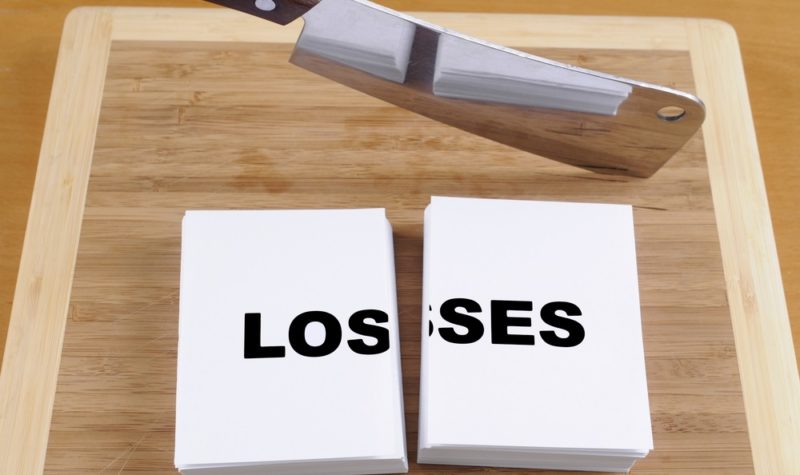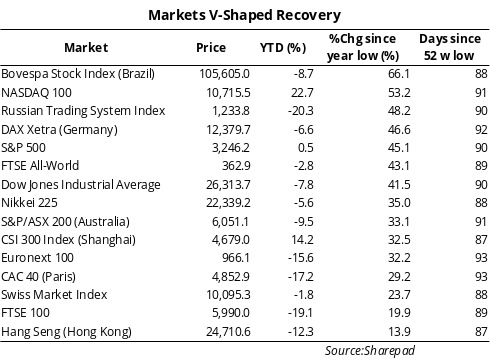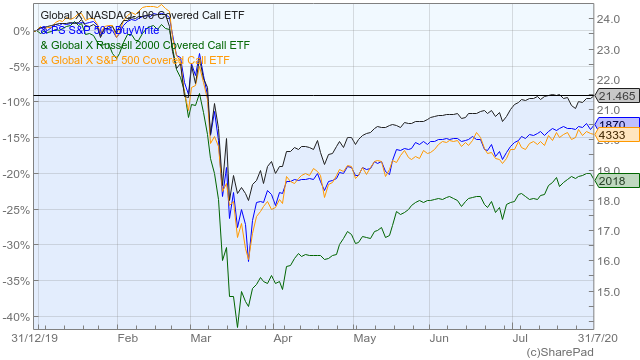Passive strategies for sideways markets

With markets near the top and an uneventful August ahead of us, the best strategy is to forego a little upside to protect against the downside.
Going all the way down, then all the way up! What’s next? Maybe nothing.
With a traditionally light trading month on the horizon and US markets having already recovered from the virus sell-off, investors are looking for clues to choose a direction, which most likely won’t come soon. Markets will likely move sideways during the next month or two. In anticipation, what we really need is to unfold a sideways strategy with an eye on downside protection. One just never knows…
The current year continues to surprise on the downside… and on the upside. At one point Brexit seemed hard to accomplish, whilst on the other it appeared a done deal; the global economy is contracting at a rate not seen since the second world war and tech companies are skyrocketing; Covid-19 left most of us locked at home and the European Union reached a historic agreement on joint bond issues. Talk about four seasons in one day!
Financial markets have been on one hell of a rollercoaster ride. At one point, between February and March, equities around the globe were brutally pushed down into bear territory, but over the second quarter they recovered at a pace that confounded many. The S&P 500 has risen 45% since hitting a low early in the year, the German Dax recovered 46% and even the more sluggish FTSE 100 was lifted by 20%. While European markets are still in the red this year, US markets have turned around and are still edging higher. However, with Covid-19 still around, unemployment rates high and the threat of lockdowns still looming all over the US and in some parts of Europe, you may well ask yourself whether this is the beginning of a new bullish trend or the final stages of a bubble.

Most of the time, the market rises and declines faster than it should in a fight between greed and fear. We always start with a heightened reaction to something, which is later corrected to catch up with reality. Covid-19 wasn’t the end of the world despite the harm it has done to the economy and public health. But it is something capable of breaking the global economy for a period. The recovery isn’t as fast as many seem to believe, as we are far from overcoming this crisis. Nevertheless, markets put all this behind them and rose as if there was no Covid-19. As a result, stocks as an asset class are currently overvalued and tech valuations are relying on inflated earnings that most likely won’t materialise. Still, investors are ignoring everything and just keep buying.
Protecting against the downside
The worst thing to do is to oppose the market, in particular when there is upside momentum. However, buying the broad market seems risky at this point and buying tech stocks may be exuberant. There’s no limit to investors’ exuberance but I’m not comfortable with buying what’s heavily overbought and highly priced. But, if I did, I would settle with foregoing some of the upside potential in exchange for some downside protection. That can be easily accomplished through the use of stock options, in particular put options.
A protective put strategy (or married put) consists of buying a stock and a put option on that underlying stock. As the put option gives the right to sell the stock at a pre-defined price (strike price), if I buy an at-the-money option (near the price of the stock), I can always exercise my right to sell the stock at that price whenever the stock price goes below that level. If the stock declines 50%, it doesn’t matter to me. The problem is that this kind of insurance is expensive, particularly when markets are volatile. The option may give me the right to sell the stock if it goes down, but I must pay the option premium, which can be substantial. Let’s look at a real example. The SPDR S&P 500 ETF Trust (NYSEARCA:SPY), which tracks the S&P 500, closed yesterday at $324. One put option with a strike price of $325 (which is near the money) expiring in one month’s time was by then trading at $8.30. Let’s say I bought both yesterday for a total cost of $332.30. At the expiry date of the option, I need the SPY to close at least at $332.30 to pay for the premium of the option, a 2.6% rise. No matter how much the market rises, I would always end with $8.30 less than if I had bought no put option. But on the other hand, if the S&P 500 declines to $300, I can exercise my right to sell it at $325. I would still lose $7.30, but that would be much less than the $24 I would lose without the option. If the decline on the S&P 500 were greater, the loss for the option holder would still be capped at $7.30 while being higher for the non-option holder.
So, for those wishing to take a relaxing vacation and to protect against any potential derailing in financial markets, buying a broad market ETF like the SPY and a put option that is near the money may work well. The premium paid is the price of the peace of mind.
Playing a sideways market
The protective put effectively puts a floor on portfolio losses, but at the expense of dragging down profits in case the market rises just mildly or goes sideways. A covered call, or call writing allows an investor to benefit from small movements in the market. The strategy consists of owning the stock and writing (selling) a call on that same stock. The call option gives the buyer the right to buy the stock at a pre-defined price (strike price). But this time you’re the seller, so you have the obligation of selling the stock to the owner of the option if he so wishes. If the option is at-the-money when issued and the stock rises in the meantime, the owner of the option will eventually exercise it. But, if the stock is below the option strike at the expiry date, the option expires worthless, as its owner would prefer to buy the stock in the market at a lower price. Let’s look at a real example with SPY, again. As of yesterday, the ETF closed at $324 and a call option expiring in one month’s time with a strike price of $325 was trading at $7.77. If I implemented the covered call strategy yesterday, it would have cost me $316.23 ($324 – $7.77). At the expiry date of the option, I won’t lose money if the SPY declines to $316.23 – a 2.4% decline – as the option premium compensates for the decline in SPY. If the decline on SPY is larger, I end up with a loss, but that will be smaller than when holding just the stock. This insurance comes at a cost though. If the SPY rises above $325, the option is exercised and I have to sell the stock for $325, foregoing the upside. However, I still keep the option premium for a gain of $7.77.
The covered call strategy is not suitable for the long term. If we look at long-term broad market returns, we see that they’re positive and around 7%, 8% or even 10% per year (depending on the extent of the period considered). The covered call works best when the market doesn’t rise or rises mildly. The strategy helps to decrease volatility and reduce uncertainty of returns while providing cushions and generating more income when the market doesn’t move by much.
A few covered call ETFs
For those looking for an off-the-shelf solution, there are many covered call ETFs in the market. They do the hard work for investors. Some are expensive, others illiquid. I will focus my analysis in four of them, which I believe to be the best options.
Global X Nasdaq 100 Covered Call ETF (NASDAQ:QYLD)
QYLD follows a covered call strategy, in which the fund buys the stocks in the Nasdaq 100 index and writes call options on the same index. The fund invests at least 80% of its total assets in securities of the Nasdaq 100 and then writes a succession of one-month at-the-money covered call options on the index. The call writing is always covered by the securities, otherwise it wouldn’t be a pure covered call strategy but rather a speculative take on the market with potentially unlimited losses. The fund invests in European options (can only be exercised at the maturity date) and closes the trades one day before the maturity date. This prevents the options being exercised and allows the fund to keep its equity structure intact. At the end of the month, QYLD seeks to distribute a portion of the income from writing the call options. Why the Nasdaq 100? Because this index is more volatile than most others, which helps to increase the price of options and therefore the premium received by the ETF is more attractive.
Since its inception, QYLD has underperformed the Nasdaq 100. But, as I mentioned above, this is more than expected. We are foregoing some upside potential for downside and volatility protection. The drawdown for this fund is much lower than for the index it follows.
The ETF was created in 2013 and trades with an expense ratio of 0.60%. Even though costs are a bit high, for the sake of investing for the short-term this is not really important. QYLD is one of the most liquid covered call ETFs.
Invesco S&P 500 BuyWrite ETF (NYSEARCA:PBP)
Invesco’s PBP targets the S&P 500 index instead of the Nasdaq 100, which means the overall volatility expected here is historically lower, thus the premiums involved in call writing are also lower. However, many S&P 500 stocks pay dividends, which together with the option premiums are reinvested instead of being paid out to help achieve a higher total return. The fund invests at least 90% of its total assets in securities that comprise the S&P 500 index and writes call options on that index every month. Similar to what happens with QYLD, these options are written at- or out-of-the-money. The expense ratio comes at 0.49%, lower than for GYLD, but its trading volume is a lot less.
Global X S&P 500 Covered Call ETF (NYSEARCA:HSPX)
Global X has many interesting, special purpose, ETF offers. In the case of covered calls, it not only covers the Nasdaq but also the S&P 500 and the Russell 2000. HSPX invests in the stocks that are part of the S&P 500 index and then writes at- or slightly out-of-the-money call options on the index to extract option premiums. The only difference between this fund and QYLD is its target, which changes from the Nasdaq 100 to the S&P 500. The fund was brought to life in June 2013 and comes with an expense ratio of 0.65%, which isn’t cheap. But, if you use this for short-term purposes, that isn’t important. In comparison to PBP, HSPX has higher fees and lower trading volume.
Global X Russel 2000 Covered Call ETF (BATS:RYLD)
RYLD was the third covered call fund created by Global X to meet growing demand for this kind of fund and covers a different angle from those already covered. The strategy is similar to that described above but the underlying target now is the small cap US Russel 2000 index. Due to its small cap coverage, this index traditionally exhibits more volatility than the S&P 500 and the options written on it are usually more expensive, thus providing higher premiums. On the one hand, investors are forfeiting some upside appreciation of the Russel 2000, but on the other, they’re collecting higher premiums.

Final words
At a time of light trading, a covered call strategy may be useful for generating profits in a flat market, providing higher returns with lower risk than the underlying investment without the option part would provide. The protective put is a full insurance strategy for those worried about downside risks but is much less effective for flat markets. In any case both strategies offer insurance for a market where the juice seems to have been squeezed already. Yet, none of these strategies are good long-term strategies. To implement a very simple strategy and for a period of one to two months, an investor would just need to buy a broad market ETF like SPY and add a long put or a short call every month. For those looking for something easier there are a few ETFs in the market that offer a covered call strategy off-the-shelf. As a final note, just never forget that, unlike a protective put, a covered call doesn’t put a cap on losses, it just adds a layer of insurance.
Comments (0)